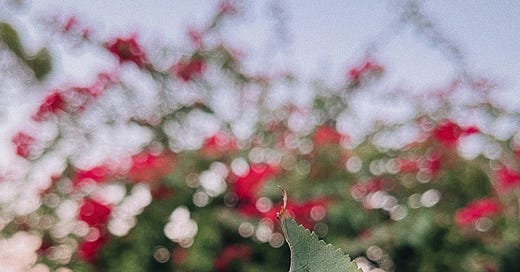February & March : Polaroids
Today, I am relieved that faith as small as a seed, or a button, or a hole on a leaf, is enough.
Hibiscus.
The single coral flower on my new hibiscus plant swings from the stem, fragile and untouchable. The morning light filters through her paper-thin petals. Her colour is daring, extravagant.
Countries are at war; does she not know?
Shamelessly, she faces the sun. By afternoon she wilts and curls upwards, defying gravity, defying my wish for her to stay.
Stretch Marks.
My child is growing and his home grows with him, stretching my skin. For now, the marks are purple, scattered across the middle of my body. The skin experts call them scars, but they don’t hurt, they’re just here, present.
I read that there are two types of pain. Physiological pain is productive and is a pain which the body creates for a purpose, like giving birth. Pathological pain serves no protective function and serve little purpose. That pain can be purposeful and can give birth to new life; this is not new to me, but now my own body will be etched with this story too.
Don’t our bodies become our own autobiographies?
Over the last few years, research projects conducted with refugees and asylum seekers, collected hair samples analysing the levels of cortisol (stress hormones) in the samples. A correlation was discovered between the levels of cortisol in the hair and the participants’ symptoms of post-traumatic stress disorder as a result of their exposure to ongoing instability.
War leaves nothing untouched - even a strand of hair.
Wooden Buttons.
I reach into the factory outlet bin under the florescent lights and pull out a cotton dress, holding it against my belly. I carry the dress along with a handful of newborn onesies to the oversized weighing scales set on a freight palette. The clothes cover less than a tenth of the scales and seem insignificant in such a cavernous warehouse, piled high with discarded things. But these clothes once belonged to somebody, somewhere.
I think about the mothers carrying their babies across borders with just the clothes on their back or a few belongings packed into a suitcase.
These clothes are discarded by choice, but what about all that has been left behind without a choice?
I take a deep breath when I see the image of a mother carrying a child across a destroyed bridge in Irpin, Northwest Kyiv, (slide 2) during heavy shelling and bombing. I notice her child’s pink onesie, a bold dot of colour in the middle of dark rubble and destruction.
Later that day, I slowly thread a needle, swapping out old plastic buttons for wooden ones and replace any that are missing along the seam. I try to find the old stitch holes but only a few are obvious enough to see. I use navy blue thread to sew eight stitches which bind each button in place. I think about the button-sized things in the sometimes-vacuous warehouse of living which bring us order, comfort and satisfaction.
I am reminded that it doesn’t take grand gestures or a global audience to love someone or something that is forgotten or abandoned. It doesn’t take a lot to make someone feel at home.
Each button becomes a prayer.
Today, I am relieved that faith as small as a seed—or a button— is enough.
With each stitch, I hum, wondering what the mothers in the bunkers, far from the sunlight, are singing to their children.
Leafcutter Bees.
We use a wood saw to cut through a piece of pine, splitting a small hole into two. A small bee emerges from the hole, humming, sleepily. I whisper an apology: we didn’t know you were there. We notice the cocoon is lined with leaves, cut like tiny blankets. Later we learn that the Leafcutter Bee snips a tidy circle from a leaf and uses these leaf pieces to weave cradles for her eggs inside small holes or burrows. Each female builds her own nest. Her button-sized leaf is the perfect size to line the home for her young.
As she cuts the leaf, she curls it under her body, holding it with her legs, and then, she flies.
The circular holes on our rose bush leaves don’t seem to bother me so much anymore.
I saw her young fly free.
Thanks for your patience, readers. Between baking a baby (!), my day job and some personal projects it’s been a busier season than expected and I didn’t manage a monthly essay in February.
For the foreseeable future, I’ll be aiming to write here once a month (even if it’s a handful of polaroids) instead of my (somewhat ambitious) original aim of twice a month. As always, I love hearing from you. Feel free to leave feedback, comments or reflections.




